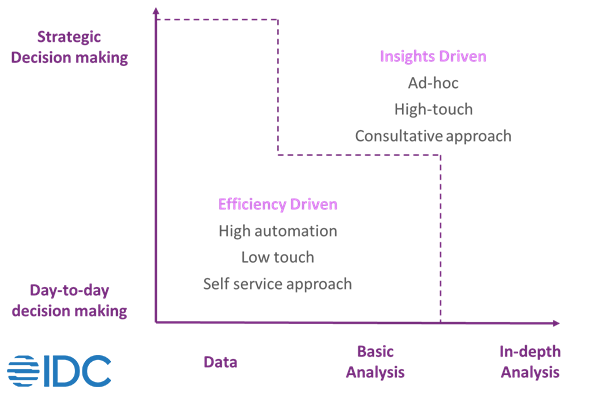Frictionless customer journeys are those that seamlessly react to customer needs, anticipate consumer responses, and follow the shopper across channels, locations, and touchpoints. They create experiences for customers that improve convenience and ease of shopping, drive loyalty, increase basket sizes, and improve profitability, ultimately creating competitive advantage in the market.
Enabling frictionless journeys isn’t as simple as implementing operational, customer-facing processes, however. Rather it requires a customer-first culture combined with deep analytical maturity to support decision-making across the organization. Analytical maturity, in turn, requires the right people, processes, and technology. But how do retailers with less mature capabilities get there, from where they sit today?
Start With the Vision—Where Are We Going?
The goal of analytically robust retail is to leverage data-driven, quantitatively derived insights, moving toward a world of far more science than art in decision-making. Retailers that get this right make rapid, scalable, integrated decisions driven from in depth analysis for every decision.
Develop the Strategy – How Will We Get There? People, Process and Technology
People
For effective analytics, there are four basic building blocks: extract data, analyze it, uncover insights, and communicate them. Good analysis starts with asking the right business question and ends with effectively communicating the relevant insight.
This process is relatively straightforward when there are a limited number of business questions to answer. However, one good analysis often leads to a lengthening pipeline of questions and a quickly overtaxed analytics group. At this point, most retailers view this as a people problem, so they hire more analysts and build additional analytics teams across the organization.
But the challenge persists. As more teams provide more answers to more parts of the organization, they lead to further questions, often deeper and more granular, which creates a growing queue of analyses and forces hyper-prioritization of the work. This scenario plays out consistently across retail organizations, regardless of the size or maturity of their analytics functions.
Retailers are awash in data, but often limited by their ability to access it efficiently. For a specific business question data may exist, but it is not structured in a way that makes it usable to the business for analysis. To achieve analytics at scale, data extraction needs to be efficient and accurate.
Many retailers would point to the prevalence of data scientists across their organization as an indicator of their mature analytics capabilities. In fact, this prevalence is a better indicator of the opposite – a company with a lower degree of analytics maturity that does not fully grasp the problem they are trying to solve. It is a solution to a problem that should not exist. Retailers don’t need more data scientists, they need better processes and tools that make data scientists less relevant. The democratization of data is giving efficient, accurate access to relevant data across the organization. Better tools give non-technical, yet analytically powerful users the ability to ask and answer ad-hoc high touch questions and deliver insight, while at the same time delivering insightful data in different forms across business users.
Process: Square Framework
Also essential for developing effective analytics processes is establishing a framework for how teams will tackle analytical questions from across the business. Developing an approach is critical for minimizing needless or unproductive requests for analytics support and for ensuring that data, analyses, and insights are delivered effectively to support decisions large and small.

A simple framework like the one shown above is a good starting point. Where the business need is data for analytically oriented associates to manipulate and produce insights, the focus should be on efficiency—deliver data to business users in the most efficient, accurate way possible. On the other hand, where deeper analysis is required, or where it impacts larger strategic decisions, a less automated and more consultative approach to analytics is required.
Technology: Integrated Intelligence for Integrated Decisions
While human-driven processes can execute in depth analyses for critical decisions, doing so with enough speed, scale, and accuracy across every decision requires intelligent solutions. Intelligent decision support extends and augments human capabilities to rapidly solve complex analytical challenges and take action against the resulting insights – doing what humans can’t – across the retail organization.
Frictionless journeys, by their very nature, ignore internally focused departmental silos and processes. Customers experience their journey across categories, departments, locations, channels, and touchpoints. To maximize the value of intelligent decision support solutions that enable frictionless journeys, retailers must break away from departmental silos and process-specific decision making to reflect impacts of a decision in one part of the business on the rest of the organization.
Decision intelligence solutions support this vision by acting as an enterprise-wide system that sits across departments, functions, and processes to improve decision making across the company and enable integrated decision-making. In practice, this enables the seamless integration of downstream decisions that have upstream impacts, automatically adjusting and assessing the impacts of one decision on other adjacent areas of the business.
Advice for Business Leaders
It’s easy then, for retailers to focus on the visible end processes to implement from an operational perspective. But to deliver true frictionless journeys that not only excite the customer, but also create long-term competitive advantage, retailers need to develop deep analytical maturity across the organization. Without this as a core building block, customer-facing operational changes are superficial at best and more likely create sub-par customer experiences. To learn more about integrating customer facing processes and technology to create frictionless journeys in retail, join us for the webinar, “Enabling Frictionless Journeys in Retail“, live on September 16th at 11 AM/ET to learn more. Click the button below to register.




